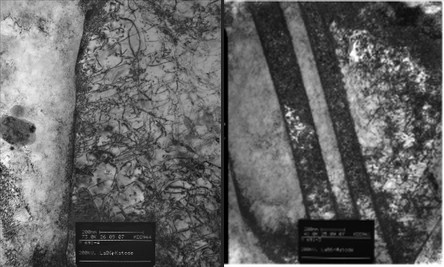Fatigue Modeling of U720
A multi-scale approach in understanding grain boundary effects on crack initiation
Michael D Sangid; Professor Huseyin Sehitoglu
Excessive scatter is observed in the fatigue response of a super nickel alloy, Udimet 720. This scatter can be partly contributed to the variability in the microstructure of this material. This project deals with linking the microstructure to fatigue properties using a multi-scale approach that focuses on integrating the results of atomic simulations (molecular dynamics) to the continuum level in the form of a crystal plasticity model. Thus, we will try to answer the following:
- Criterion for crack initiation of U720
- How do mis-orientated grains affect the fatigue properties?
- How does a grain size distribution, specifically a small grain adjacent to a large grain, affect the fatigue properties of a material?

TEM images displaying dislocation pile-ups at grain boundaries and twinned regions, respectively (in collaboration with H.J. Maier).

Atomic simulations analyzed the roll of grain orientation (as shown above in the CSL structure) on interfacial energy of bicrystals.